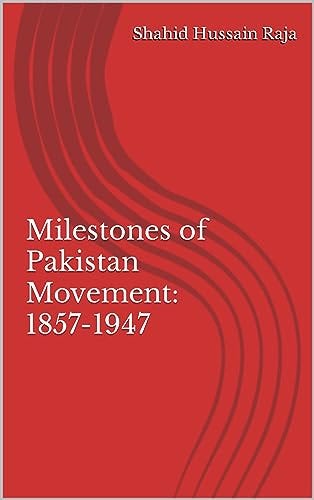All India Muslim League, 1906: Genesis and Significance

Introduction
Founded on December 30, 1906, in Dhaka, the All India Muslim League was a political organization that aimed to represent the interests of Indian Muslims during the period of British colonial rule. Its founding was primarily driven by concerns among British Indian Muslim elites about their political representation and the protection of their rights. They felt that the Indian National Congress, which was the leading organization advocating for independence from British rule, did not adequately address the specific concerns and interests of the Muslim community.
The All-India Muslim League played a significant role in the political landscape of India during the early 20th century. It organized annual sessions, worked to mobilize Muslim support, and promoted its political agenda. The league’s efforts contributed to shaping the political discourse and the eventual partition of India.
Context
Every event has a context, the peculiar situation obtaining on the ground at that particular moment in history, which gives the specific causes responsible for that event greater relevance than any other point in time. Some of the peculiar features of the situation before the formation of the Muslim League were as follows:
1. Start of Political Reforms in British India
Fearing another “1857-style mutiny,” the new British Crown was forced to become more liberal and democratic while dealing with the Indians and provide them with some safety valves through which they could express their grievances and channel frustration and a sense of exclusion. It resulted in the first establishment of local government institutions, and the municipal boards/corporations of Bombay, Calcutta, and Madras were created.
But this system proved futile, as from 1892 to 1906, not even a single Muslim representative could secure a seat in the legislative councils, as the local bodies were also dominated by Hindus, who always voted on religious grounds. The British Indian Muslim elite was becoming acutely conscious of this political marginalization of their community in the new political governance system being introduced by the British colonialists and was thinking of creating a political organization of their own.
2. Countering Religious Militancy in Indian Muslims
Although the 1857 uprising was a common struggle among the Indians, with Hindus playing equally, if not more, than their Muslim compatriots, it was the British Indian Muslims who were singled out, individually and collectively, by the English for retribution. This blatant discrimination against Indian Muslims inevitably resulted in the creation of three types of classes, each a trend blazer:
- Islamists: Islamists, who ascribed the fall of the Mughal Empire to the Muslims' deviation from their religion, advised aloofness from mainstream social and political life to Muslims and tried to revive the old Islamic spirit of jihad through religious education.
- Loyalists: Loyalists, to gain material benefits from the victors, openly sided with the British and perpetuated the strength of the empire for another 90 years.
- Moderates: Moderates who thought that the British were here to stay for long innings and the violent overthrow was impossible. They, therefore, advocated the acquisition of modern Western knowledge and stressed cooperation with the British to safeguard their rights.
Fearing that the first group, namely Islamists, might take over the leadership of the Indian Muslims using the religious card, the British encouraged the other two groups to come forward and lead the Muslims. The Simla Delegation was the start of this policy of inducting Muslim moderates into the political stream in the same way they had done with the Hindus by forming the Indian National Congress.
3. Birth of three Separatisms
The 1857 War of Independence led to several trends, of which three are the most important: Indian nationalism, Indian Muslim separatism, and its offshoot, Bengali Muslim separatism
- Indian Nationalism: While the Indian Muslims were still in a shell shock after the 1857 War and the revenge taken by the British, the Hindu population seized the initiative, became more educated, and gained lucrative positions in the Indian Civil Service: many ascended to influential posts in the British government. This economic empowerment of Hindus led to their collective consciousness of being the true inheritors of Indian civilization, which led to their intensive Indianization.
- Indian Muslim Separatism: One of the biggest offshoots of the 1857 uprising was the increased rift between the two major communities of British India, namely Hindus and Muslims. On the other side, systematic persecution of Muslims led to their subconscious development as a separate nation, which led to the creation of Indian nationalism among the Hindus
- Origins of Muslim Bengali Separatism: Bengal was punished for its alleged pioneering role in the uprising. Not only was the economic development of this region neglected, but Bengalis in general and Bengali Muslims, in particular, were also systematically kept out of the decision-making processes in Colonial India. It led to the development of a separate Bengali Muslim nationalism.
While the Indian Hindus got their own political party, namely the Indian National Congress, the British Indian Muslims realized the need for a similar organization to safeguard their national interests.
4. Partisan Attitude of Indian National Congress
Although claiming to represent all Indian nationalities, Congress turned out to be a predominantly Indian Hindu organization. From the very start of its existence, the Congress had shown a clear interest in safeguarding the rights of Hindus, alone. Some of the Congress leaders adopted a revolutionary policy to establish a Hindu Raj in the sub-continent under the guise of a national movement. The Muslims of India were greatly disappointed by the anti-Muslim stance that Congress seemed to have adopted.
5. Partition of Bengal/Urdu-Hindi Controversy
The events following the partition of Bengal and the Urdu-Hindu controversy strengthened the desire of the Muslims to organize themselves politically as a separate community. The Urdu-Hindu controversy began with the demand of Hindus to replace Urdu with Hindi as an official language in Deva Nagari Script. Sir Anthony Macdonal, the then Governor of UP, ousted Urdu from public offices. Congress sided with Hindi and supported the movement against Urdu, and there was no other political party to support Urdu.
6. The Evolution of Minto Marley Reforms
The turning point came in the summer of 1906, during John Morley’s budget speech, in which he hinted at constitutional reforms. At that time, Muslims did not have a political platform to demand their share. It was reasserted that they wanted a separate political platform.
7. The Success of Shimla Deputation
The Shimla Delegation was the first formal effort by the Indian Muslim elite to safeguard the interests of their community by presenting their demands to the highest authority in British India. It became essential for Muslims to establish a political party of their own when Minto offered the fullest sympathy to Muslim demands. The success of the delegation compelled the Muslims to have a separate political association of their own.
Course
A resolution to form the All-India Muslim League was passed by Nawab Salimullah Khan and seconded by Hakim Ajmal Khan, Maulana Muhammad Ali, and Moulana Zafar Ali. The resolution was passed by the All-India Educational Conference on December 30, 1906. A committee was formed to prepare its draft constitution. Sir Agha Khan was appointed as President and Syed Hassan Balgrami was appointed Secretary, while Nawab Mohsin-ul-Mulk and Nawab Viqar-ul-Mulk were made joint secretaries with six Vice Presidents, and a Central Committee with forty Members was also constituted. In this way, the Muslim League was established and became the sole representative of Muslims.
The Muslim League laid out the following points as its objectives.
- To create among Muslims feelings of loyalty towards the British Government and to remove misconceptions and suspicions.
- To Safeguard the political rights of Muslims and bring them to the attention of the Government.
- To prevent, among Muslims, the rise of prejudicial feelings against the other communities of India.
The first session of the all-India Muslim League was held in Karachi on December 29, 1907, and was presided over by Adamji Peer Bhai.
It was felt from the beginning that the All-India Muslim League would not achieve considerable success without winning the British public's support. Therefore, Syed Ameer Ali organized the branch of the Muslim League in London.
Impact
1. First Formal Political Platform for British Indian Muslims
Every political party is formed with the following objectives in mind:
- Interest Articulation: Interest articulation refers to the process whereby the demands of the various interest groups in society are formulated and expressed in the form of a desired plan of action.
- Interest Aggregation: Interest aggregation refers to sorting out the diverse and often conflicting demands of various interest groups and making compromises.
- Political Socialisation: Political socialisation is the process of educating the masses about the rules of the political game, their constitutional rights, and their responsibilities under the law of the land.
- Political Recruitment: To recruit men of integrity, letters, action, and leadership to its fold as members and prepare them for election in the future and to reach the higher echelons of power.
- Feedback: Keeping the government in power about the reaction of the public to its various policies and actions, a watchdog function
The Indian National Congress (INC) was formed in 1885 to seek political rights and representation for Indians under British colonial rule. Similarly, the All India Muslim League was the first formally organized political platform representing the geographical and cross-sectional representation of the British Indian Muslims to articulate the demands of the British Muslims and present them to the higher authorities as a sole representative. Because of its high-profile leadership and mass following, it was difficult for the British Government, British Indian Government, India, and other parties to ignore the demands they were making
2. Vanguard of Pakistan Movement
Keeping in view the historical context of Hindu-Muslim rivalry in the Sub-continent, Pakistan was an inevitability, but the way it was created by launching a constitutional movement, all credit goes to the Muslim League. In contrast, keep in mind the way other countries, particularly in Africa, got their independence. From the day the Muslim delegation won recognition of the demand for a separate electorate, the course of the Muslim freedom struggle was charted. The Muslim League became a mass movement of Muslims and succeeded in achieving Pakistan in 1947.
3. Leadership Funnel
Like any other political party, the Muslim League was instrumental in the political socialization of the British Indian Muslims as well as in recruiting and training the political leadership for the running of a state. It was the Muslim League that helped produce the bulk of the leadership, which not only created Pakistan but also helped steer the new country after its formation.
From the book “Milestones of Pakistan Movement: 1857–1947”
Thanks for reading the article. If you like it, kindly show it by clicking the clap icon as many times as you like, and sharing it with your friends on social media
You are welcome to contact me at my Twitter account @Shahid_H_Raja for any assistance.
